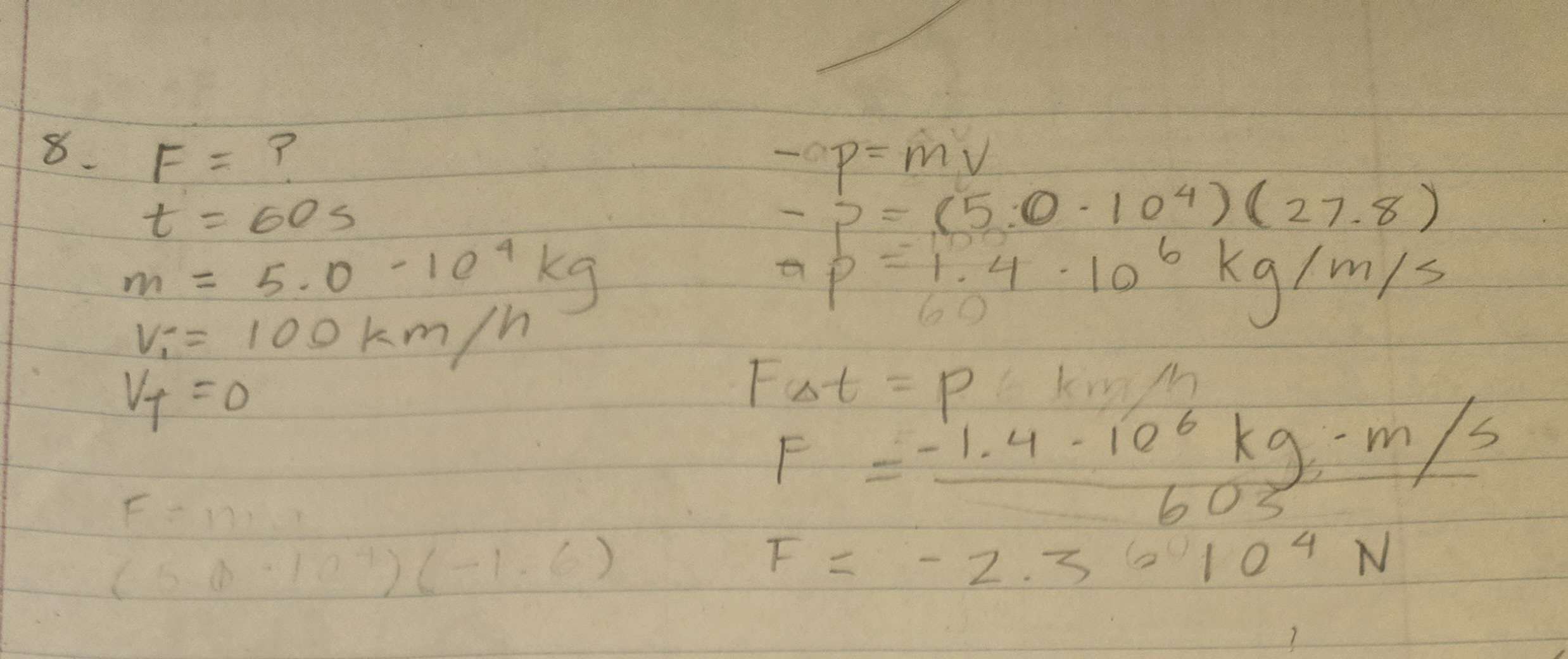Physics 11
1/40
There's no tags or description
Looks like no tags are added yet.
Name | Mastery | Learn | Test | Matching | Spaced |
|---|
No study sessions yet.
41 Terms
A 95 fullback, running at 8.2 m/s, collides in midair with 128 kg defensive tackle moving opposite direction. Both players end up with zero speed.
a.) What was the fullback’s momentum before the collision?
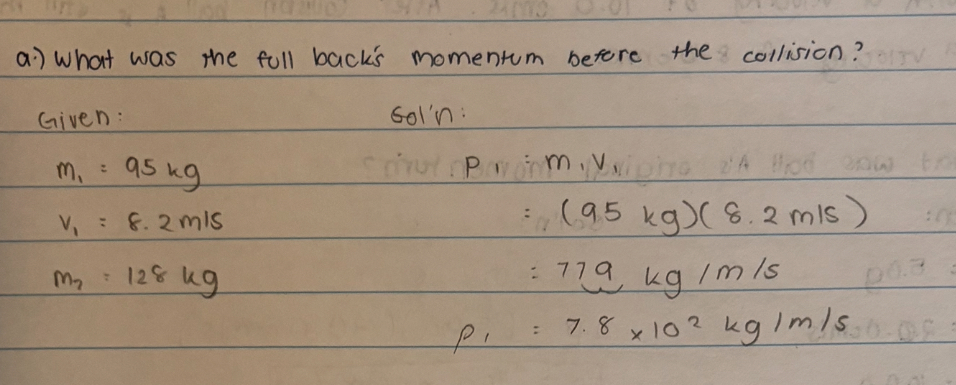
A 95 fullback, running at 8.2 m/s, collides in midair with 128 kg defensive tackle moving opposite direction. Both players end up with zero speed.
b.) What was the change in the fullback’s momentum?
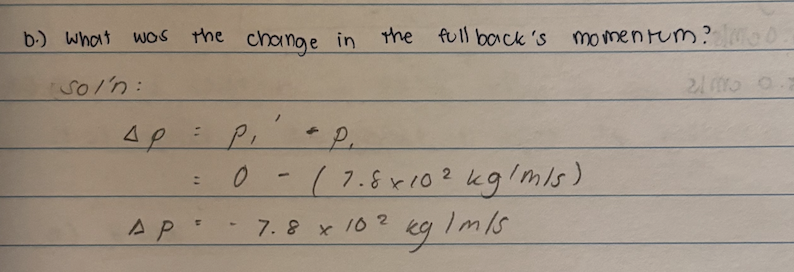
A 95 fullback, running at 8.2 m/s, collides in midair with 128 kg defensive tackle moving opposite direction. Both players end up with zero speed.
c.) What was the change in the tackle’s momentum?

A 95 fullback, running at 8.2 m/s, collides in midair with 128 kg defensive tackle moving opposite direction. Both players end up with zero speed.
d.) What was the tackle’s original momentum?
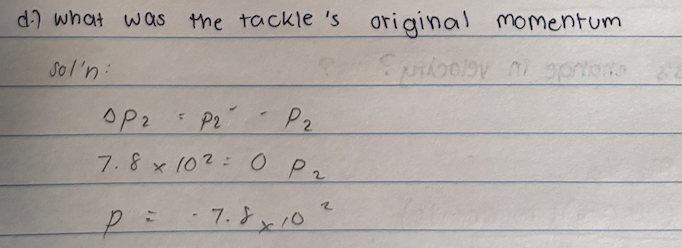
A 95 fullback, running at 8.2 m/s, collides in midair with 128 kg defensive tackle moving opposite direction. Both players end up with zero speed.
e.) How fast was the tackle’s original momentum?
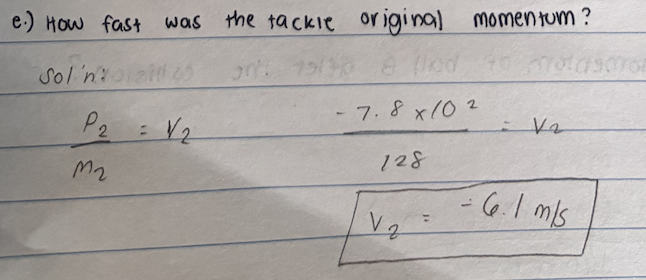
A. 4.00kg model rocket is launched, shooting 50.0 g of burned fuel from its exhaust at an average velocity of 625 m/s. What is the velocity of the rocket after the fuel has burned?
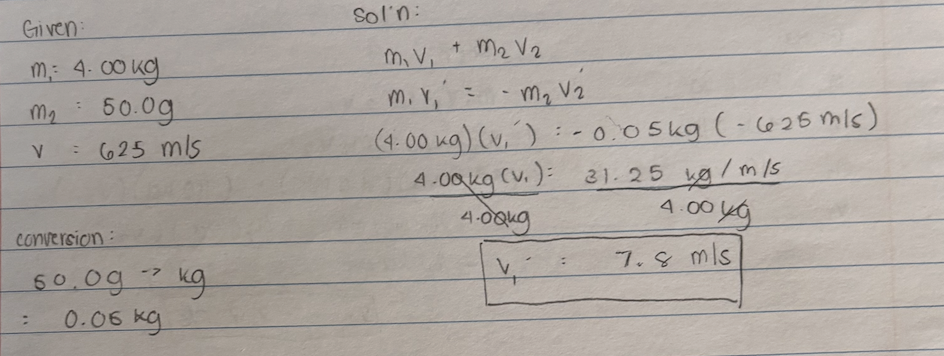

A thread holds two carts together on a frictionless surface. A compressed spring acts upon the carts. After the thread is burned, the 1.5 kg cart moves with a velocity of 27 cm/s to the left. What is the velocity of the 4.5kg cart?
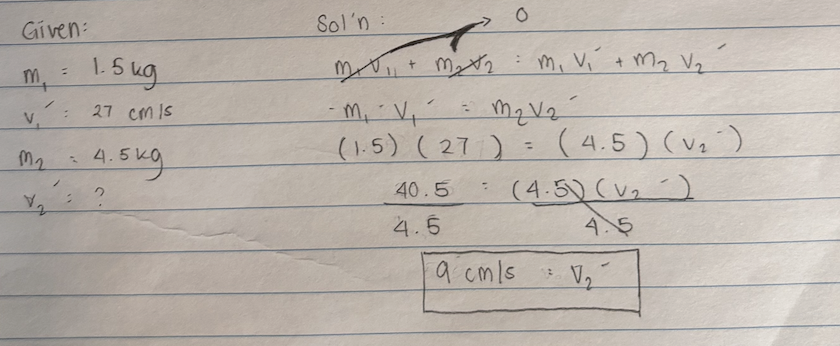
Two campers dock a canoe. One camper steps onto the dock. This camper has a mass of 80.0 kg and moves forward at 4.0 m/s. With what speed and direction do the canoe and the other camper move if their combined mass is 110 kg?
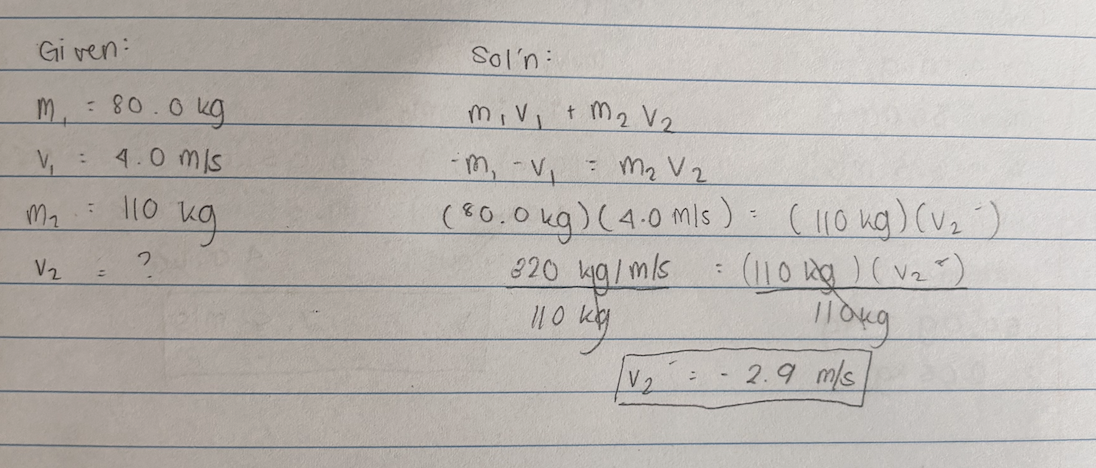
A glass ball, ball A of mass 5.0g, moves at a velocity of 20.0 cm/s. It collides with a second glass ball, ball B, of mass 10.0 g, moving along the same line with a velocity of 10.0 cm/s. After collision, ball A is still moving, but with a velocity of 8.0 cm/s.
a.) What was ball A’s original momentum?
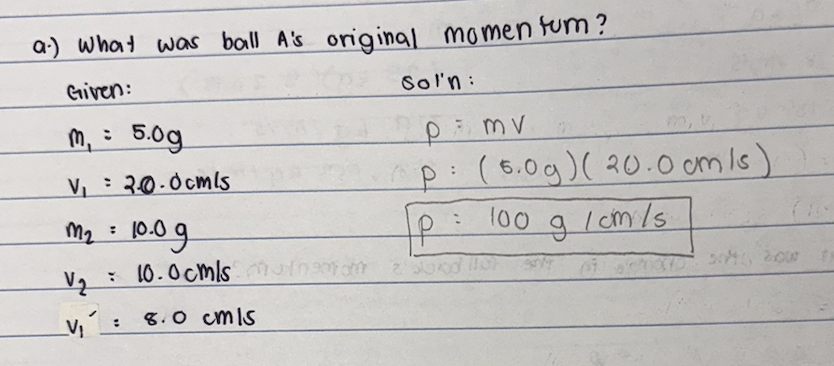
A glass ball, ball A of mass 5.0g, moves at a velocity of 20.0 cm/s. It collides with a second glass ball, ball B, of mass 10.0 g, moving along the same line with a velocity of 10.0 cm/s. After collision, ball A is still moving, but with a velocity of 8.0 cm/s.
b.) What is ball A’s change in momentum?
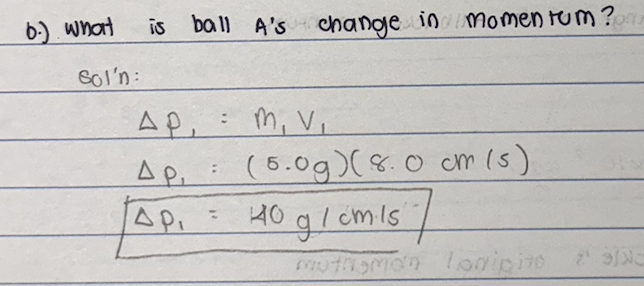
A glass ball, ball A of mass 5.0g, moves at a velocity of 20.0 cm/s. It collides with a second glass ball, ball B, of mass 10.0 g, moving along the same line with a velocity of 10.0 cm/s. After collision, ball A is still moving, but with a velocity of 8.0 cm/s.
c.) What is ball B’s change in momentum?
A glass ball, ball A of mass 5.0g, moves at a velocity of 20.0 cm/s. It collides with a second glass ball, ball B, of mass 10.0 g, moving along the same line with a velocity of 10.0 cm/s. After collision, ball A is still moving, but with a velocity of 8.0 cm/s.
d.) What is the momentum of ball B after the collision?
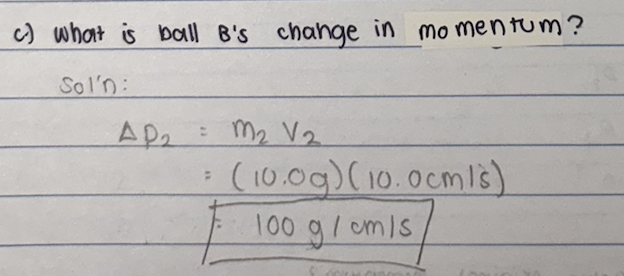
A glass ball, ball A of mass 5.0g, moves at a velocity of 20.0 cm/s. It collides with a second glass ball, ball B, of mass 10.0 g, moving along the same line with a velocity of 10.0 cm/s. After collision, ball A is still moving, but with a velocity of 8.0 cm/s.
e.) What is ball B’s speed after the collision?

Before a collision, a 25 kg object is moving at 12 m/s. Find the impulse that acted on this object if after the collision it moves at:
a.) 8 mls
in progress
Before a collision, a 25 kg object is moving at 12 m/s. Find the impulse that acted on this object if after the collision it moves at:
b.) -8 m/s
in progress
A 275 kg van runs into the back of a 825 kg compact car at rest. They move off together at 8.5 m/s. Assuming no friction with the ground, find the initial speed of the van.
in progress
A 15 g bullet is shot into a 5085 g wooden block standing on a frictionless surface. The block, with the bullet in it, acquires a velocity of 1.0 m/s. Calculate the velocity of the bullet before striking the block.
in progress
A hockey puck, mass 0.115kg, moving at 35.0 m/s, strikes an octopus thrown on ice by a fan. The octopus has a mass of 0.265 kg. The puck and octopus slide off together. Find their velocity.
in progress
A 0.105 kg hockey puck moving at 48 m/s is caught by a 75 kg goalie at rest. With what speed does the goalie slide on the ice?
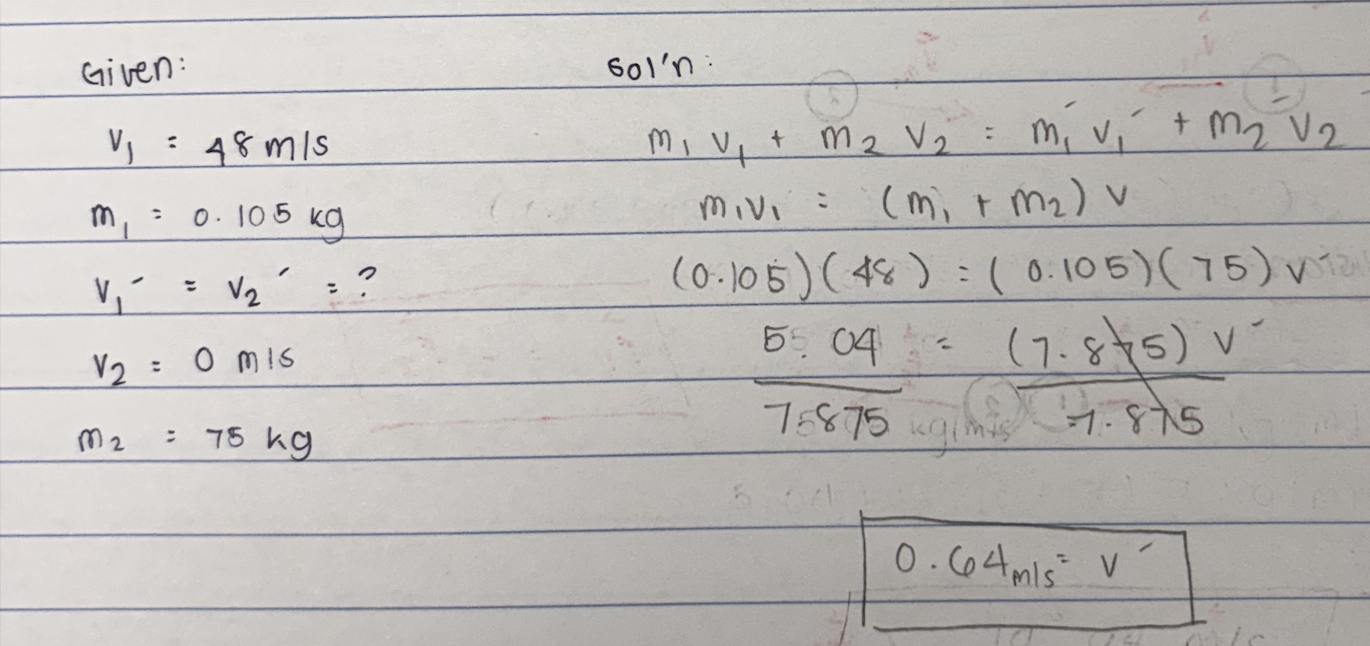
A 35.0 g bullet strikes a 5.0 kg stationary wooden block and imbeds itself in the block. The block and the bullet fly off together at 8.6 m/s/ What was the original velocity of the bullet?
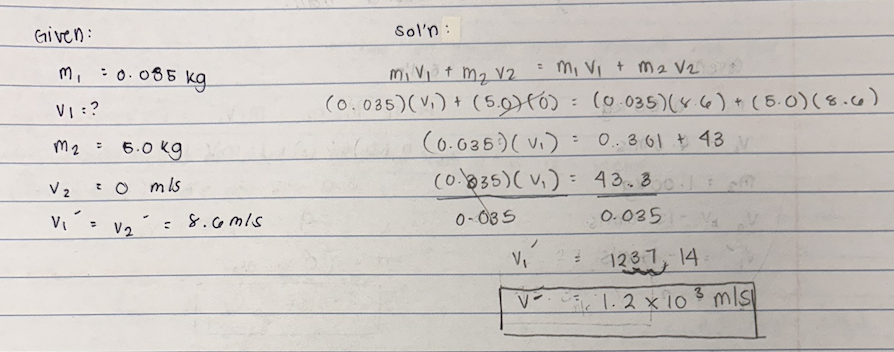
A 35.0 g bullet moving at 475 m/s strikes a 2.5 kg wooden block. The bullet passes through the block, leaving at 275 m/s. The block was at rest when it was hit. How fast is it moving when the bullet leaves.
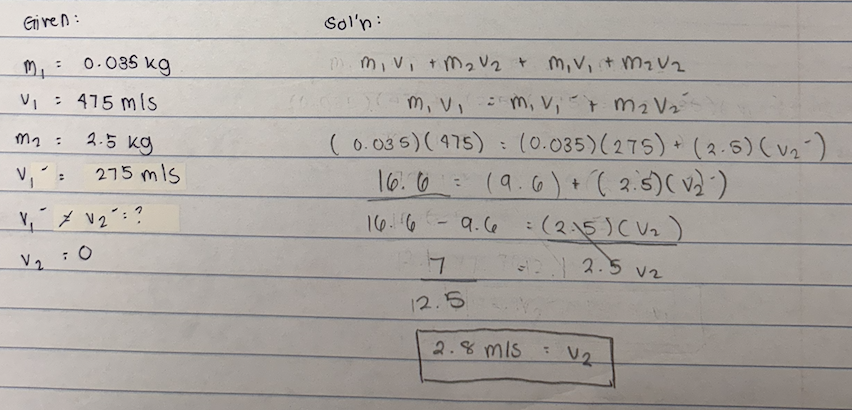
A compact car, mass 725 kg, is moving at 100 km/h
a.) Find its momentum
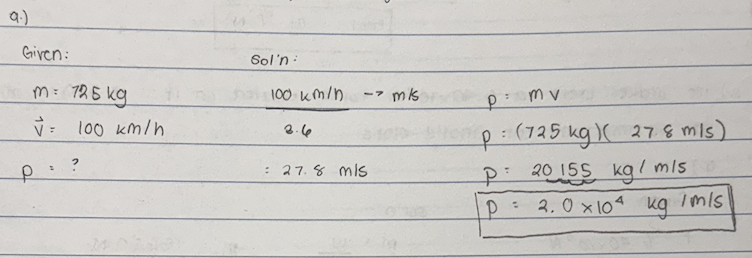
A compact car, mass 725 kg, is moving at 100 km/h
b.) At what velocity is the momentum of a larger car, mass 2175 kg equal to that of the smaller car?

A snowmobile has a mass of 2.50 ×10² kg. A constant force is exerted on it for 60.0s. The snowmobile’s initial velocity is 6.00 m/s and its final velocity 28.0 m/s.
a.) What is its change in momentum?
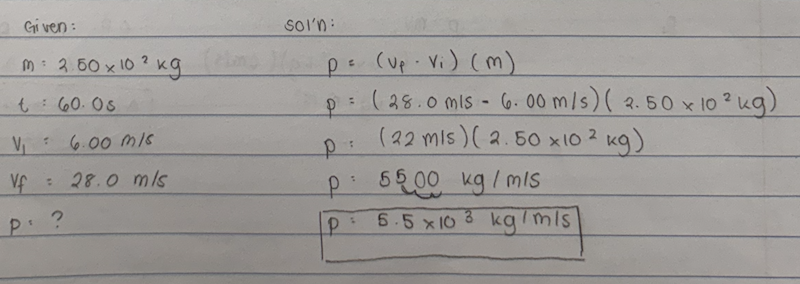
A snowmobile has a mass of 2.50 ×10² kg. A constant force is exerted on it for 60.0s. The snowmobile’s initial velocity is 6.00 m/s and its final velocity 28.0 m/s.
b.) what is the magnitude if the force exerted in it?
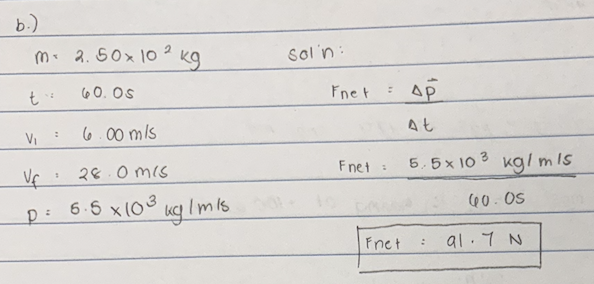
The brakes exert a 6.40 ×10² N force exerted on it? 15680 N and moving at 20.0 m/s. The car finally stops.
a.) What is the car’s mass?
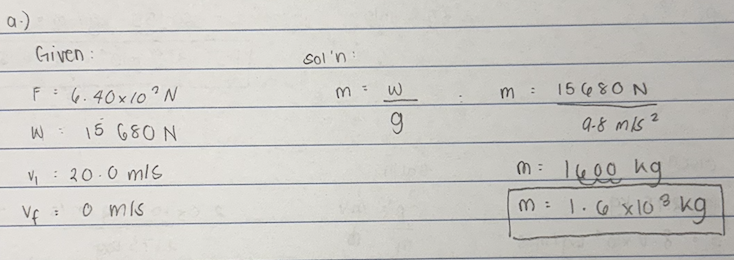
The brakes exert a 6.40 ×10² N force exerted on it? 15680 N and moving at 20.0 m/s. The car finally stops.
b.) What is its initial momentum?
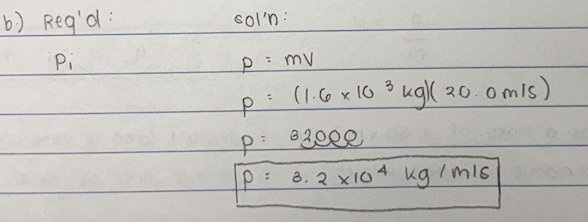
The brakes exert a 6.40 ×10² N force exerted on it? 15680 N and moving at 20.0 m/s. The car finally stops.
c.) What is the change in the car’s momentum?

The brakes exert a 6.40 ×10² N force exerted on it? 15680 N and moving at 20.0 m/s. The car finally stops.
d.) How long does the braking force act on the car to bring it to a halt?
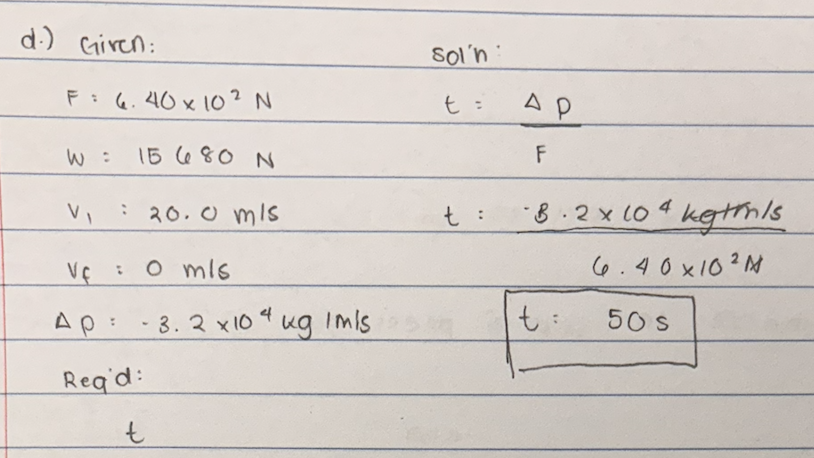
A bowling ball of mass 5.0kg travelling at 13.0m/s is slowed to 5.0m/s (in same direction) in a time interval of 2.5 seconds. What is the average retarding force on the ball?

An airplane of mass 5.2×104 kg accelerates uniformly from rest for 56 seconds along a runaway and takes off at a speed of 72 m/s
a.) What is the thrust exerted by the engines?

An airplane of mass 5.2×104 kg accelerates uniformly from rest for 56 seconds along a runaway and takes off at a speed of 72 m/s
b.) How far does the plane travel during takeoff?
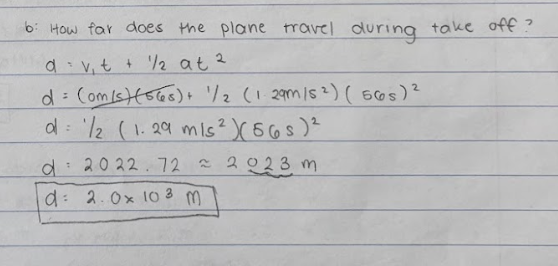
A tennis ball of mass 55 grams travelling horizontally at 7.0 m/s is struck by a racket wielded by a tennis player and is sent back at 8.0 m/s. The collision lasts for 0.12 seconds.
a.) What is the average force exerted by the racket on the ball?
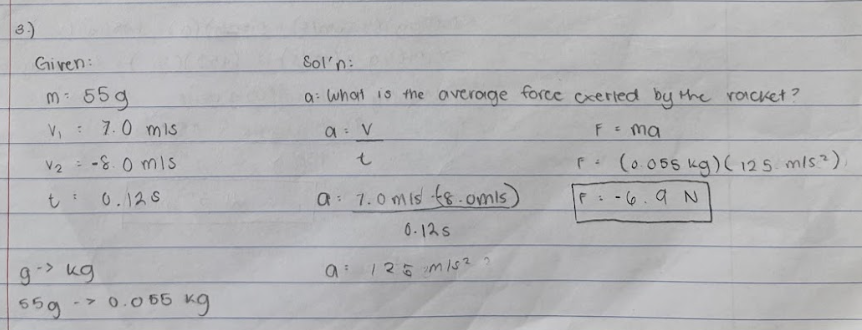
A tennis ball of mass 55 grams travelling horizontally at 7.0 m/s is struck by a racket wielded by a tennis player and is sent back at 8.0 m/s. The collision lasts for 0.12 seconds.
b.) If the mass of the racket is known, can the concept of momentum conservation be used to predict the recoil speed of the racket?

A 1200 kg artillery gun fires a 34 kg shell at a velocity of 770 m/s horizontally. Neglecting friction, what is the recoil speed of the gun?

A puck mass of 450 grams travelling at a speed of 32 cm/s collides head-on with a stationary puck 150 gram puck.
a) If the two stick together on impact (a completely inelastic collision), what is their common speed?

A puck mass of 450 grams travelling at a speed of 32 cm/s collides head-on with a stationary puck 150 gram puck.
b) If the pucks undergo a partially elastic collision and the lighter puck travels on with a speed of 32 cm/s, what is the resulting velocity of the first puck?
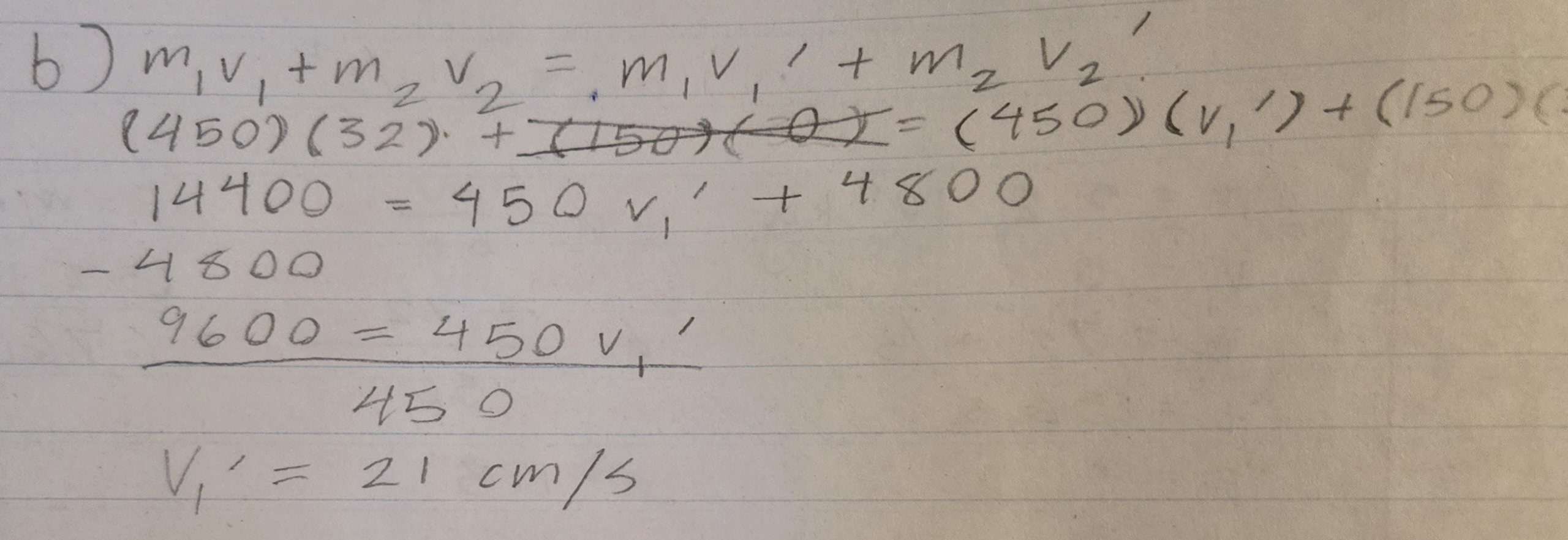
A puck mass of 450 grams travelling at a speed of 32 cm/s collides head-on with a stationary puck 150 gram puck.
b) If the pucks undergo a perfectly elastic collision, the lighter puck travels off at 48 cm/s. Predict the final velocity of the first puck.

A 64 tonne boxcar travelling at 8.0 km/hr rams a train consisting of 12 similar boxcars travellings at 5.0 km/hr in the same direction. Predict the resulting speed of the train, given that the 13 cars lock together.

A 2200 kg car travelling South on an icy road at 15 m/s, collides head on with a 5500 kg truck travelling at 8.0 m/s North. If the two lock together, what is their common velocity just after impact.

Estimate the force exerted on a vertical wall by 100 km/h wind. Assume that the air stops on impact and that over a 1.0 minute perioud 5.0 × 104 kg of air contacts the wall.
